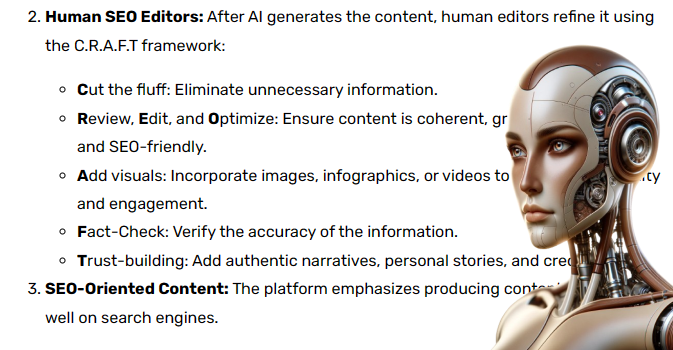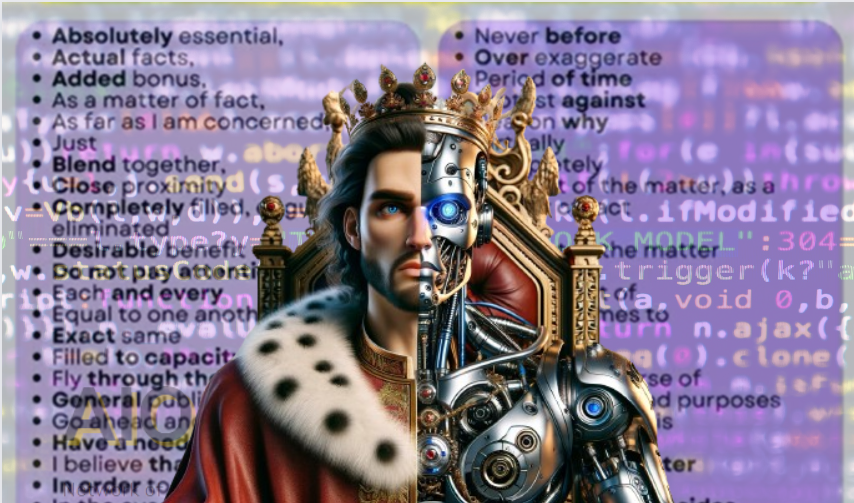Hello and welcome. The question is: how to cut the fluff?
If you’re looking to improve the quality of your AI content, you’ve come to the right place. At AIOEditors, we leverage artificial intelligence and human expertise to produce top-notch content that resonates with your audience. However, even with the most advanced technology, it’s crucial to have strong editing skills to make your content concise and compelling. That’s why we’ve put together this guide to help you cut the fluff from your writing and make it more impactful.
By following these 6 AIO editing tips, you can simplify your writing and improve the clarity of your message. Start by establishing a clear purpose and identifying your target audience to streamline your content. Identify and remove filler words and phrases, break long sentences into shorter ones, and use bullet points and subheadings for clarity. Prioritize relevant information and edit and revise for conciseness and clarity.
Effective communication is all about clarity over clutter. With these AIO editing tips in mind, you can cut the fluff from your AI content and deliver concise communication that resonates with your audience.

Why Cutting the Fluff is Important for Effective Communication
When creating AI content, it’s easy to get carried away with excessive details and tangents. However, to ensure your message is communicated clearly and concisely, it’s essential to eliminate unnecessary information and improve clarity.
Effective communication is all about concise communication. By trimming the fluff and getting straight to the point, you can deliver your message more effectively to your audience. Eliminating unnecessary information can also ensure that your content is easier to read and comprehend, particularly for those short on time.
AIOEditors.com‘s platform leverages artificial intelligence and human expertise to produce high-quality content. We know cutting the fluff is crucial to achieving concise communication that resonates with your audience.
Don’t let unnecessary details distract from your intended message. By eliminating the fluff, you can achieve precise, impactful communication that captures your audience’s attention and compels them to act.

How to Cut the Fluff in Your AIO Content?
AIO Writer & Editor’s Guide: Eliminate 50 Filler Words
The bold part of the word can be deleted completely, while the other words (not bold) can be replaced.

Start with a Clear Purpose and Target Audience
When cutting the fluff from your AI content, starting with a clear purpose and identifying your target audience can streamline your content and simplify your writing. By doing so, you can deliver a concise, impactful, and relevant message to your readers. As a user of AIOEditors, a platform that leverages artificial intelligence and human expertise to produce high-quality content, these editing tips can help you optimize your writing process.
To achieve a clear purpose, define the main point you want to communicate to your audience. Think about why your message matters and why your readers should care. With your target audience in mind, focus on the key points that are most relevant to them. Avoid tangents that do not contribute to your main message, and eliminate unnecessary information that may clutter your content.
| Tip: | Use a content brief or outline to organize your thoughts and ensure your writing focuses on your intended purpose. |
|---|
Simplifying your writing is just as important as streamlining your content. Use language that is easily understood by your target readers, avoiding jargon or technical terms that may confuse them. Keep your sentences concise and direct, avoiding unnecessary words or repetitions. Doing so can ensure that your message is clear and impactful.
Tip: If you’re struggling to simplify your writing, speak your message out loud and then transcribe it. This can help you write in a more casual, conversational tone.
Identify and Remove Filler Words and Phrases
Filler words and phrases can clutter your content and make it less concise. These are words and phrases that don’t add meaning to your message, such as “um,” “like,” “you know,” and repetitive phrases such as “in order to” or “at this point in time.” Using too many fillers can dilute the power and impact of your writing. Trimming these unnecessary details can make your writing more direct and impactful.
To remove filler words and phrases from your writing:
- Read your content out loud: This will help you identify any unnecessary fillers you may have used unconsciously.
- Use the “find” function: Use the search function in your text editor to look for specific words and phrases that you tend to overuse, such as “basically” or “actually.”
- Trim as much as possible: Once you’ve identified filler words and phrases, remove as many as possible without sacrificing meaning or clarity.
Removing filler words and phrases makes your writing more concise and impactful. Your readers will appreciate the clarity and focus of your message and the time and effort you’ve put into trimming unnecessary details.

Break Long Sentences into Shorter Ones to Reduce Verbosity and Streamline Content
One of the most effective ways to cut the fluff from your AI content is to break long sentences into shorter ones. Long sentences can be challenging to read, causing confusion and leading to verbosity. By breaking them down into faster, more straightforward sentences, you can streamline your content and make it more reader-friendly.
To break long sentences into shorter ones, start by identifying the sentence’s main idea. Then, separate it into two or more shorter sentences conveying a specific point. This way, you can ensure that every sentence contributes to your intended message without getting lost in convoluted sentence structures.
Shorter sentences improve readability and help create a sense of pace and rhythm in your writing. This can help keep your audience engaged and interested in your content. Remember to vary your sentence length to avoid monotony and keep your readers on their toes.

Use Bullet Points and Subheadings for Clarity
Organizing your content through bullet points and subheadings can significantly improve clarity and streamline your content.
When it comes to bullet points, keep them concise and use them to summarize essential information briefly. Bullet points are great for breaking down complex ideas or procedures into small, digestible chunks of information. Here’s an example of how you can use bullet points effectively:
- Start with a clear purpose and target audience
- Identify and remove filler words and phrases
- Break long sentences into shorter ones
- Use bullet points and subheadings for clarity
- Prioritize relevant information
- Edit and revise for clarity and conciseness
On the other hand, subheadings allow you to break down your content into sections, making it easier for readers to navigate and digest. Use descriptive and informative titles for subheadings to give readers a brief overview of what to expect in each section. Here’s an example of how you can use subheadings effectively:
Identify and Remove Filler Words and Phrases
“Filler words and phrases can clutter your content and make it less concise.”
| Filler Words and Phrases | Alternative Phrases |
|---|---|
| um | pause, think |
| like | similar to, for example |
| you know | understand, right |
Using bullet points and subheadings can make your writing more visually appealing and easier to read, improving your readers’ overall experience. It’s a simple yet effective way to streamline your content and communicate your message.

Prioritize Relevant Information for Concise Communication
Eliminating unnecessary information is crucial for achieving concise communication. To ensure that your message is clear and impactful, it’s vital to prioritize the most relevant information. By doing so, you can eliminate any tangents or details that do not contribute to the main point you are trying to convey.
| What to prioritize: | What to eliminate: |
|---|---|
| Key points that directly support your message | Tangents and unnecessary details |
| Information that is important to your target audience | Repetitive or redundant statements |
| Clear and concise statements | Fluff content and filler words |
Focusing on what truly matters, you can achieve concise communication that effectively resonates with your audience. AIOEditors.com, the platform that leverages artificial intelligence and human expertise to produce high-quality content, can help you prioritize and streamline your writing for maximum impact.
AIO Editing Tips for Simplifying Your Writing
Editing and revising are critical steps in ensuring your AI content is concise and impactful. By following these AIO editing tips, you can simplify your writing and create precise and effective communication.
Tip #1: Remove Unnecessary Words
Eliminate any words or phrases that do not contribute to the main point of your writing. This includes redundant phrases, filler words, and vague language. Simplify your sentences using clear, concise language that gets straight to the point.
Tip #2: Use Active Voice
An active voice makes your writing more direct and impactful. Instead of using passive voice, which can lead to wordiness and confusion, use active voice to convey your message.
Tip #3: Avoid Repetition
Repeating the same information or ideas can make your writing less concise. Eliminate any unnecessary repetitions and focus on communicating each concept effectively.
Tip #4: Simplify Sentence Structure
Long, complex sentences can lead to confusion and make your writing less concise. Use shorter, more straightforward sentences to convey your message clearly and effectively.
Tip #5: Use Clear and Concise Language
Avoid using overly complicated language or technical jargon that may confuse your readers. Instead, use clear and concise language that is easily understood by your target audience.
Tip #6: Get Feedback
After you’ve edited and revised your content, get feedback from others to ensure your message is clear and impactful. This can be done using AIOEditors, a platform that leverages artificial intelligence and human expertise to produce high-quality content.
By following these AIO editing tips, you can simplify your writing and create concise communication that resonates with your audience.

How to Cut the Fluff?
Cutting the fluff in your writing is crucial for creating clear, concise, and impactful content. Here’s how you can achieve this:
- Identify Redundant Phrases: Look for phrases that don’t add value to your content. For example, “absolutely essential” can often be shortened to just “essential”.
- Avoid Overused Fillers: Words like “just,” “really,” and “very” often contribute little to your message. Scrutinize their necessity in each sentence.
- Be Direct and Specific: Instead of saying, “I believe that,” or “In my opinion,” state your thoughts directly. This removes unnecessary qualifiers.
- Use Active Voice: Active voice typically requires fewer words than passive voice, making your writing more dynamic.
- Read Aloud for Clarity: Reading your content aloud can help you catch and remove superfluous words and phrases.
- Rely on Strong Verbs and Nouns: Using strong verbs and nouns can reduce the need for additional adjectives and adverbs.
- Edit Ruthlessly: Be willing to cut words, sentences, or even entire paragraphs if they do not serve the purpose of your content.
By following these steps, you can effectively ‘cut the fluff’ from your writing, making it more engaging and more accessible for your audience to understand.
FAQ
Why is cutting the fluff necessary for effective communication?
Cutting the fluff eliminates unnecessary information and improves clarity, allowing for concise communication that captures your audience’s attention and delivers your message effectively.
How can I start cutting the fluff from my content?
Start by establishing a clear purpose and identifying your target audience. Streamline your content by focusing on the key points most relevant to your audience, and simplify your writing by using language your target readers easily understand.
What are filler words and phrases, and why should I remove them?
Filler words and phrases are unnecessary words or phrases that clutter your content. Examples include “um,” “like,” and “you know.” Removing them helps trim unnecessary details and makes your writing more direct and impactful.
How can I make my sentences more concise?
Break long and convoluted sentences into shorter, more concise ones. This reduces verbosity and confusion, making your content easier to read and understand.
How can bullet points and subheadings improve clarity?
Organizing your content using bullet points and subheadings improves clarity. Bullet points effectively summarize essential information, while subheadings break down your content into sections, making it easier for readers to navigate and digest.
How do I prioritize relevant information in my content?
Identify the most relevant information for your message and prioritize it. Eliminate unnecessary details or tangents that do not contribute to the main point, ensuring concise and impactful communication.
What steps should I take to edit and revise my content?
Editing and revising are essential for cutting the fluff. Review your writing for clarity and conciseness, eliminating redundancies and unnecessary repetitions. Simplify your sentences and ensure that every word contributes to your intended message.
Why should I focus on concise communication?
Concise communication is essential for effective messaging. Trimming unnecessary details and achieving clarity helps your audience better understand and engage with your content.
How can I achieve concise writing?
Following the 6 AIO editing tips outlined in this article, you can trim unnecessary details, improve clarity, and streamline your content for effective communication. Remember, concise writing is all about clarity over clutter.
Conclusion
Trimming unnecessary details is essential for achieving concise communication. Following the 6 AIO editing tips outlined in this article, you can streamline your content, improve clarity, and effectively convey your message to your audience.
Remember, AIOEditors is a platform that leverages artificial intelligence and human expertise to produce high-quality content. Using our platform and implementing these editing tips ensures that your AI content is concise, impactful, and engaging.
Thank you for reading, and we hope these tips help you in your writing journey towards concise communication. Remember that cutting the fluff will become second nature with practice, and you’ll be a pro in no time!


